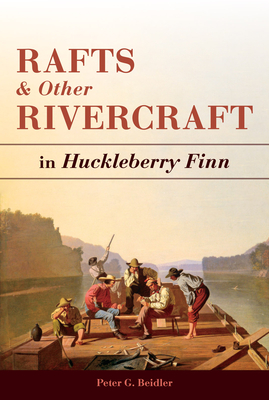
Rafts and Other Rivercraft: in Huckleberry Finn (Mark Twain and His Circle)
Description
The raft that carries Huck and Jim down the Mississippi River is often seen as a symbol of adventure and freedom, but the physical specifics of the raft itself are rarely considered. Peter Beidler shows that understanding the material world of Huckleberry Finn, its limitations and possibilities, is vital to truly understanding Mark Twain’s novel. He illustrates how experts on Twain’s works have misinterpreted important aspects of the story due to their unfamiliarity with the various rivercraft that figure in the book.
Huck and Jim’s little raft is not made of logs, as it is often depicted in illustrations, but of sawn planks, and it was originally part of a much larger raft. Beidler explains why this matters and describes the other rivercraft that appear in the book. He gives what will almost certainly be the last word on the vexed question of whether the lengthy “raft episode,” removed at the publisher’s suggestion from the novel, should be restored to its original place.
Praise for Rafts and Other Rivercraft: in Huckleberry Finn (Mark Twain and His Circle)
“Dr. Beidler’s critiques of inaccurate literary analyses and book illustrations will be of real value to historians and archaeologists with an interest in the navigation and trade on the western rivers, as well as to professionals in the field of American literature, and especially to all readers who want to know about the river world of Huck Finn.”—Kevin Crisman, author of The Eagle: An American Brig on Lake Champlain during the War of 1812
“The raft in Huck Finn, as every reader knows, is a symbol of home and freedom. But was it a log raft (as generally depicted), or a lumber raft? Who owned it? Did it comprise a mere fragment of a larger craft, or a symmetrical “crib”? Peter Beidler has long been the Noah of the raft episode and its rightful place in Mark Twain’s masterpiece. In this little book, structured largely as a series of answers to rhetorical questions about the nomenclature and physical makeup of rivercraft in Mark Twain’s works and elsewhere, Beidler exerts complete salvage rights over the raft itself. Much as the cetology chapters deepen our understanding of Mody-Dick, Beidler’s detailed annotations give us a solid grub stake—not the monetary share of conventional dictionary definitions but, in the river lexicon of the nineteenth century, a sturdy handle or connecting rod—for grasping the material culture of Huck Finn and, thus, enlarging our understanding of the book as a whole.”—Thomas Cooley, The Ohio State University; editor, The Norton Critical Edition of Huckleberry Finn
“Every so often a new book comes along that jolts us into realizing we don't understand Mark Twain nearly as well as we think. Peter G. Beidler's Rafts and Other Rivercraft in "Huckleberry Finn" is just such a book. Before reading it, I wouldn't have believed there is enough to say about rafts, canoes, skiffs, and other rivercraft in Huckleberry Finn to justify a book-length study. Not only has Beidler proven me wrong, his fascinating and thorough exposition of the complexities and significance of rafts and other craft in the novel has made me feel like I had been reading the book with blinders on. Written in an engaging Q&A style, Rafts and Other Rivercraft offers an eye-opening and stimulating observation on almost every page. Do not read Huckleberry Finn again until you've read this book!”—R. Kent Rasmussen, author and editor of many books on Mark Twain including Mark Twain A to Z: The Essential Reference to His Life and Writings
“Beidler convincingly demonstrates that understanding watercraft and river lingo are as important for Huckleberry Finn as whaling terms and practices are for appreciating Moby-Dick. There’s no other guide for the subject as clear-headed and useful as this one.”—Peter Schmidt, Swarthmore College, author of the essay "The ‘Raftsmen’s Passage,’ Huck’s Crisis of Whiteness, and Huckleberry Finn in U.S. Literary History”
